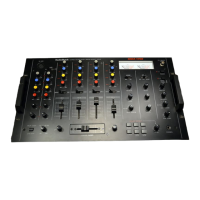11
Operation
4. Set the desired channel volume level
slide control to the preset position.
5. Adjust
CUE LEVEL
to a comfortable lis-
tening level.
6. Start playback of the input source you
want to play next through your sound
system.
7. Set the input device to the desired sec-
tion of music, then stop or pause the
input device.
Switching to the Second Input
Source
1. Start playback of the second input
source.
2. Slide
CROSS FADER
from
A
to
B
when
you are ready to play the second
source’s sound through your sound sys-
tem.
Slide
CROSS FADER
:
• To the left to fade in the channel
selected by
ASSIGN A
and fade out
the channel selected by
ASSIGN B
.
• To the right to fade in the channel
selected by
ASSIGN B
and fade out
the channel selected by
ASSIGN A
.
• To the
center
to equally mix the two.
Notes on Mixing
• If you set
CROSS FADER
to
A
to play the
channel selected by
ASSIGN A
, then you
must set
CUE ASSIGN
to
CH 1
to monitor
CH 1
, to
CH 2
to monitor
CH 2
, to
CH 3
to
monitor
CH 3
, and to
CH 4
to monitor
CH
4
. The same applies when you set
CROSS FADER
to
B
.
• To mix any two inputs selected by the
ASSIGN
switches, set each
ASSIGN
switch to the desired channel. Then use
CROSS FADER
to mix the two.
• Do not slide
CROSS FADER
to the center
if you want to
monitor
one channel while
the other is playing. Otherwise, the
sound from the channel you monitor will
also be heard through your sound sys-
tem. Instead, slide
CROSS FADER
to the
channel you are not monitoring. For
example, to monitor channel 1 (selected
by
ASSIGN A
) while channel 2 (selected
by
ASSIGN
B
) is playing, slide
CROSS
FADER
to
B
.
• Use
CUE LEVEL
to listen to the input
controlled by the
CUE ASSIGN
switch
and what is playing on the currently
selected output device.
USING THE SPECIAL
CONTROLS
Using the Tone Controls
Your mixer has a set of tone controls for
each microphone and for channels 1–4. You
can tailor the high, middle, and low frequen-
cy sounds for each.
For normal sound, leave
BASS
,
MID
, and
HIGH
set to
0
.
Rotate
HIGH
,
MID
or
BASS
toward
+10
to in-
crease, or toward
–10
respectively to de-
crease the high, middle, and low frequency
sounds.
Using Gain
Since the input levels of each sound source
are different, the
GAIN
controls let you fine
tune each selected input's volume. Rotate
the desired
GAIN
control toward
MAX
to in-
crease the volume and toward
MIN
to reduce
it.
32-3008.fm Page 11 Thursday, April 6, 2000 4:03 PM

